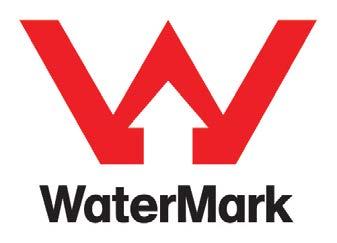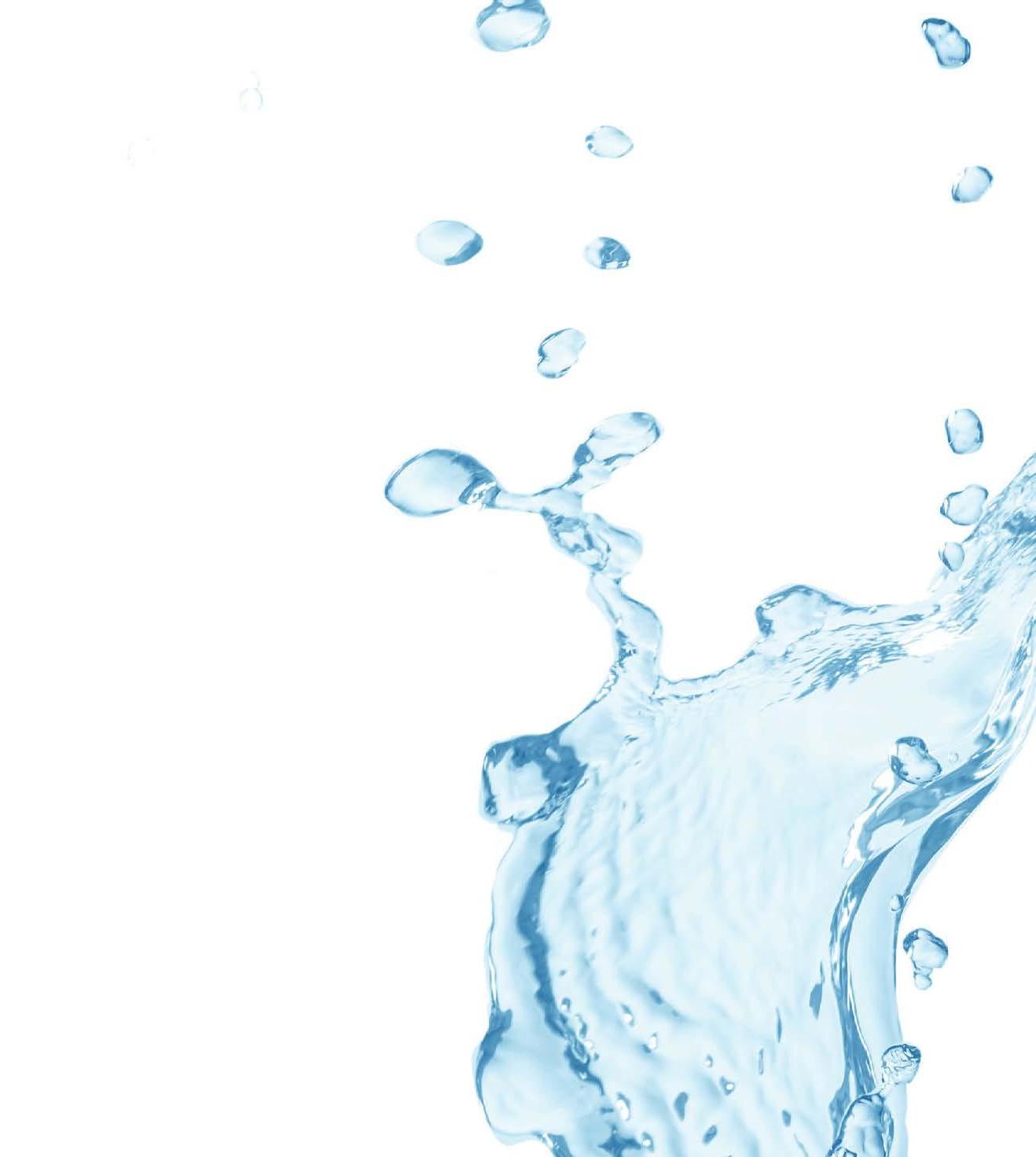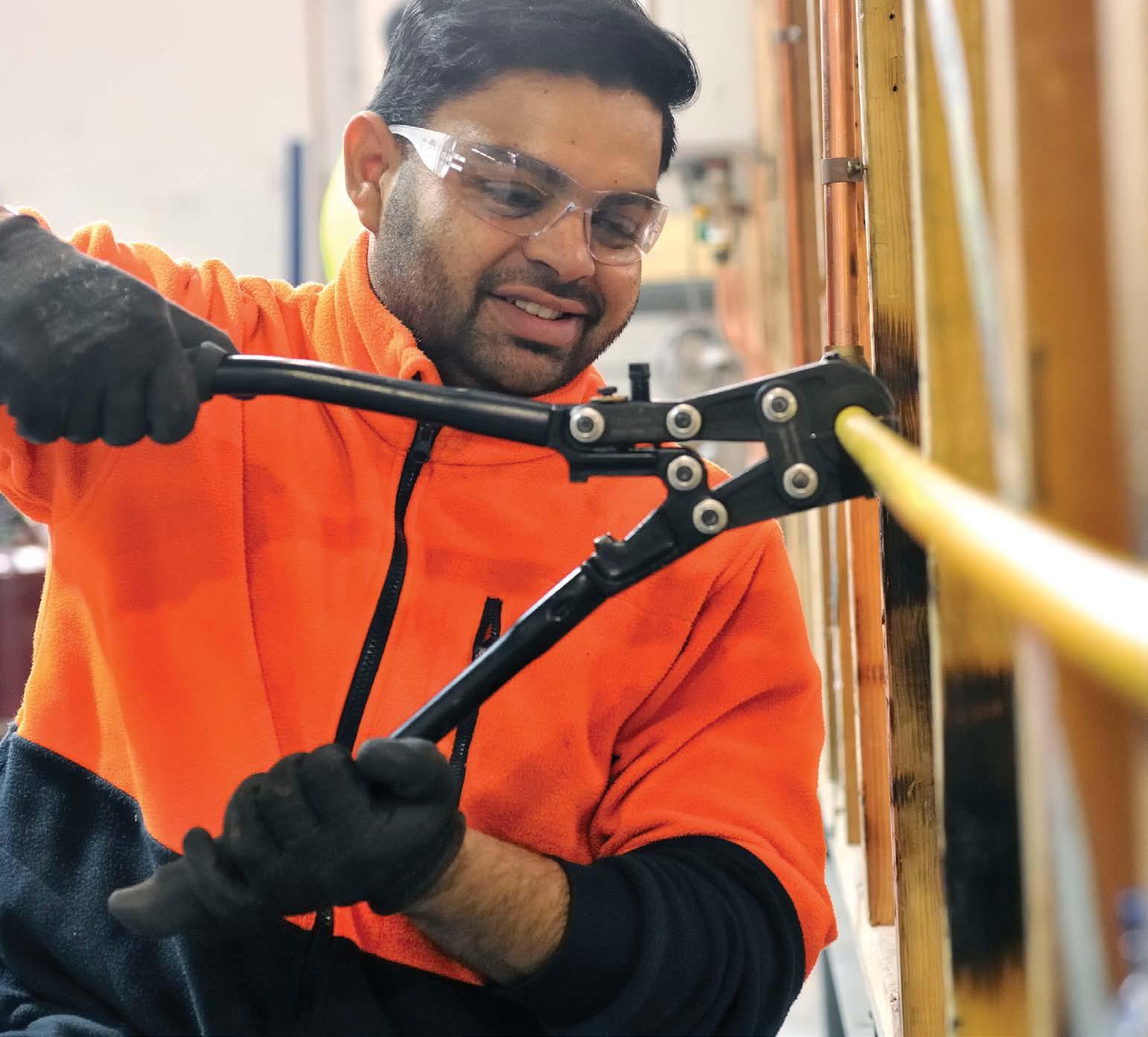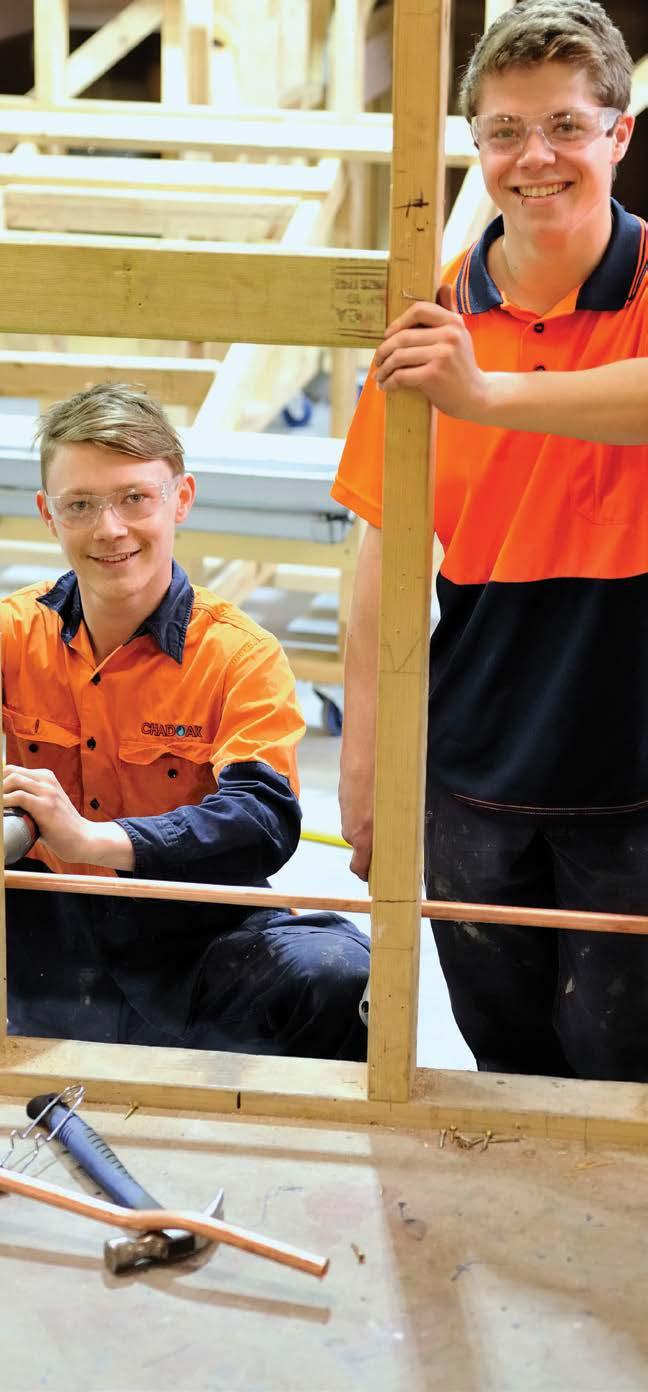
17 minute read
WaterMark or not
There is confusion aplenty for consumers and problems for plumbers when it comes to compliance. Plumber and Master Plumbers’ technical expert Gary Bath explains.
Plumbers often talk about the number and variety of Australian Standards they must comply with when installing water and sanitary drainage work. However, how many plumbers would have AS/NZS4129 fittings for polyethylene (PE) pipes for pressure applications or AS/NZS4936 air admittance valves (AAVs) for use in sanitary plumbing and drainage systems? The answer: very few. Why? Plumbers have been conditioned to refer to WaterMark as the required approval for any products used in a plumbing system. A fixture, fitting or pipe that carries this symbol or certification details has met the required Australian Standards for use in that installation.
The Australian Building Codes Board (ABCB) licenses and manages the WaterMark scheme and develops the certification requirements for each product that requires WaterMark. Not all products used for plumbing installations require WaterMark certification. Fixtures such as basins, sinks and baths do not require a WaterMark approval, however the waste outlets used in each of these fixtures does. Other exclusions include evaporative air conditioners, bain-maries and domestic dish and clothes washing machines. Stormwater pipes and fittings also do not require WaterMark certification, but many of these products are still required to meet an Australian Standard specification. To meet the ‘deemed to satisfy’ requirements of plumbing installations for sanitary drainage and water supply, plumbers must only install products that carry the WaterMark certification. It is not however illegal to sell plumbing products without a WaterMark certification. This adds to the confusion for many consumers who buy these products only to find their plumber refuses to install them. It then falls to the installing plumber to police the use of appropriately certified products, rather than the responsibility of the merchandisers who sell them. Further complications arise when some of these products are bought online or from overseas. Certain popular hardware merchants will have both WaterMark and non-WaterMark products sitting side by side with obvious price comparison being the choice offered to the consumer.
Even with a WaterMark product, the installing plumber often must ascertain additional installation requirements to ensure the work is compliant with the AS/NZS3500 requirements. A good example are bidet seat douches, which are gaining popularity with consumers panic buying toilet paper during COVID-19.
All bidet douche seats must have a WaterMark and must be installed by a plumber, although some products advise otherwise. If the outlet or spray on the seat is less than 25mm above the rim of the toilet, a high-risk backflow solution is required. A reduced pressure zone device or the installation of a registered break tank is appropriate, but would leave the consumer facing additional costs. Further complications arise when we look at the WaterMark certification for bidet douche seats set out in WMTS-051:2016 WaterMark technical specification. This technical requirement relates to toilet douche seats used in commercially available WC pans and intended for direct connection to the water supply. These douche sets must be supplied with a low hazard mechanical backflow prevention device (complying with AS/NZS 2845.1).
WaterMark or not

There is an extensive list of products that do require WaterMark:

Appliances: glass washing machines, bedpan sterilisers, commercial clothes washing machines, among others. Each has specific certification requirements to meet WaterMark approval.
Sanitary fixtures: cisterns, water closets, bidets, and bidet douche seats.
Tapware: taps, flexible hose assemblies, thermostatically controlled taps, and showerheads.
Devices and controllers: flow control valves, rainwater connections, flow sensors, leak protection valves, prefabricated cold-water storage tanks and water hammer arrestors.
Heated water devices: instantaneous water heaters, water storage heaters, boiling water dispensers, solar water heating systems and heated water circulating devices. Valves/isolation: ball valves, butterfly valves, gate valves, globe valves, hot water isolation valves and solenoid valves. Valves – backflow prevention: non-return valves, single check valves, RPZD and pressure vacuum breakers.
Valves – general: pressure ratio valves, pressure reduction valves, pressure limiting valves and tempering valves.
Fire service: fire sprinkler heads (domestic only).
Jointing products: brazing alloy, solder, lubricant, priming fluid and solvent cement, and roll groove fittings.
Pipework: all products, metallic or otherwise approved for use in sanitary drainage or water supply installation.
Pipe fittings: all fittings for use within sanitary drainage or water supply installations.
Shafts and pumping stations: inspection shafts, maintenance
shafts. Systems: purpose-built bathroom modules, bathroom appliances, modular heated water systems. Sanitary waste flushing and dosing systems are a growing category of Watermarked products and one Master Plumbers believes should be under further scrutiny. Concern should also be around the difference between a manufacturer’s warranty, which in some cases is two years, and the responsibilities of the installing plumber, which can be up to 10 years in insurance coverage.
WaterMark ups and downs

WaterMark as a certification has a unique role to play and at its best should supply the public and the installing plumber with the assurance it is compliant with the National Construction Code. At its worst, there is the potential for whole plumbing systems to be manufactured and WaterMark compliant without requiring any of the construction to be completed by a qualified plumber.
Start with safety

Further regulation required for passive fire installations in Victoria, as Gary Bath explains.
Passive fire protection (PFP) is valuable for the safety of people in a building and to minimise damage to a building. Through effective compartmentalisation, the structural integrity of a building can be maintained to ensure the safe evacuation of occupants during a building fire. Just as importantly, passive protection stops smoke and other toxins from spreading throughout the building, which can be just as damaging as fire.
What is PFP? Passive fire protection (PFP) is an integral part of the structural fire protection and fire safety in any building. PFP systems are designed to contain flames in certain parts of a building and resist ignition in the first place. This resistance is structural and designed to compartmentalise a building and isolate a flame, preventing the spread of fire from room to room and floor to floor. These systems range from fire walls, doors, and floors to protect the room surfaces, to fire-resistant sealants and intumescent products to protect plumbing services throughout the building.
Why do we need better regulation? For something that is so important to the integrity of a structure and the safety of people, it is worrying to note the inadequacies that exist in training, inspection, certification, and compliance for installation of PFP systems in Victoria. This is a position long held by the plumbing industry in Victoria.
Issues around training, compliance, certification, and reporting must be addressed to ensure that passive fire systems are: Identified as a necessary part of the building construction; Installed correctly by trained individuals; Inspected and certified by trained personnel; and reported to the right industry bodies such as building surveyors/certifiers.
What about training? There is currently a lack of training at any level within the plumbing industry for passive fire controls. Training would need to be developed specific to plumbing systems that addresses an individual’s knowledge and skill base to:
Apply rules and regulations to installation operations;
Prepare for system installation;
Prepare the fireproofing substrate or fire stopping opening for the system;
Install the passive fire and smoke containment system;
Label or mark and certify the passive fire and smoke containment system; and
Complete the installation. Neither Plumbing nor Construction qualifications contain any competencies that cover PFP systems. The only existing training competency is CPPFES3040A – Install passive fire and smoke containment systems. It is hosted with the Property Services skills sector and it is currently under review. Further work is needed to identify plumbing-related training within this scope of activity. Overseas training courses that may be suitable for transition can complement the existing content produced by manufacturers of passive fire controls to form the basis of an industry training model. Initially, this would be classed as post-trade training but there would be sufficient support for training set at Certificate III level or below that could be included as a core or elective within plumbing apprentice training.
What inspection, certification and reporting models are available? There are a diverse range of inspection and certification models that exist to address the needs of passive fire installations in Victoria. These range from well-documented and recorded site-specific models, where the building certifier for that building took a hands-on role in documenting and recording both the installation and manufacturer specification on the type of passive control used, to ‘independent’ inspection certifications that are carried out by the manufacturer on the product used.
What’s Master Plumbers’ view? Master Plumbers is advocating for the self-certifying model for our plumbing industry in Victoria. This is where appropriately-trained individuals take responsibility for the work they perform. Master Plumbers argues the Plumbing Regulations must incorporate this model to ensure PFP is part of the scope of plumbing work. Additionally, a detailed database that records all the necessary information required by building certifiers will form the cornerstone of a system that enables oversight and maintenance of passive fire installations across the state both now and into the future.
An industry-developed program would provide consistency around compliance and mitigate the need for building certifiers to conduct postinstallation compliance inspections. This will also allow our industry to drive greater awareness and conformity in this area within a suggested training and compliance pathway.
Get behind CPD in Victoria


Victoria moves one step closer to mandatory Continuing Professional Development for plumbers.
The Victorian Department of Environment, Land, Water and Planning is considering submissions on a consultation paper outlining options for a new Continuing Professional Development (CPD) scheme.
The Department received submissions from across the industry, including Master Plumbers, and plans to release Regulatory Impact Statement (RIS) at the end of 2020 or early 2021. The Statement will outline costs and benefits of three options explored and recommend a preferred option. The RIS will be open for further comment and Master Plumbers will strongly support the introduction of mandatory CPD to ensure ongoing competency and improvement of our industry. Master Plumbers President Scott Dowsett welcomed the open process and encouraged the entire industry to endorse the move to make the scheme mandatory. “The plumbing industry provides the community’s first line of defence against a whole series of hazards, diseases, toxins, and other harms,” he said. “Each of us relies every day on the skills and knowledge of plumbing professionals to ensure our water is clean, our public and private sanitation systems work and prevent disease, and that the heating, cooling and fire protection systems in our built environment are properly installed and safely maintained.”
A well-structured and implemented CPD scheme can help plumbers keep up-to-date as standards and regulations change, technologies launch and business requirements alter. Scott said CPD would build industry capacity and resilience. “If the COVID crisis has taught us one
thing it is that ensuring key industries are resilient and have the capacity to adapt and not collapse under pressure, is key to our long-term outlook. “The key is to design a scheme which is relevant to all practitioners, has the right mix of technical and industry and professional development units and is designed to gain and retain practitioner buy-in and not become compliance driven.”
A CPD framework for Victoria: The options
Three high-level options have been put forward by DEWLP for consideration:
1 Maintain the current situation – do not introduce mandatory CPD
2 Introduce a mandatory program, without any compulsory subjects
3 Introduce a mandatory program with a mixture of compulsory and non-compulsory subjects
CPD is currently mandatory in Tasmania for all licensed plumbers and gasfitters. However, it is voluntary in all other jurisdictions including Victoria. Schemes, including Master Plumbers’ CPD, in Victoria (plumber.com.au/cpd) deliver benefits to many practitioners, and by extension consumers and the community. Scott said voluntary programs were unlikely to deliver the sorts of industry wide, compliance, consumer protection, or professional development outcomes, which the industry requires. “They tend to attract those who are already keeping on top of industry developments rather than those who are most likely to need upskilling.”
Master Plumbers is advocating for Option 3
The mixed model proposed as Option 3 in the Discussion Paper would allow a balance to be struck, by mandating some units, while allowing practitioners the flexibility to choose and tailor the balance of their CPD units. Master Plumbers believes that the framework should include both technical as well as professional support units (noncompulsory) in areas such as business management, compliance and taxation or practical training in things like hygiene and disease prevention. The broad framework to establish CPD should be set out in the Plumbing Regulations, but the specific units of competency required should not be prescribed in regulation. Doing so would make the operation of the scheme difficult, would limit its flexibility and therefore utility, leading to reduced industry and practitioner engagement. An industry committee or body, made up of suitably skilled representatives across the sector, should have the responsibility for deciding the units which make up the CPD course offerings, especially any compulsory units. The role of the regulations would then be to empower and enable that decisionmaking body, rather than to prescribe the actual units of CPD.
The benefits of mandatory CPD
In an industry as dynamic as plumbing – where new innovations, technologies, systems, techniques, and materials are being developed, refined, combined, and incorporated into the built environment every day – ongoing, post trade qualification training is not a “nice to have.” It is vital and necessary to ensure currency.
What is CPD?
CPD is the recognition of ongoing learning and training. It is how plumbers can maintain, update and broaden their knowledge, expertise and competence.
Scott said Master Plumbers believed that mandatory CPD would be a valuable addition to the existing framework for the regulation of plumbing in Victoria. “Ongoing practitioner competency verification through CPD, is a particularly important consumer protection/ compliance measure in regulatory settings such as Victoria’s, which relies so heavily on self-certification,” he said.
Flexibility and relevance are key to the scheme’s success
Introducing a CPD scheme is a significant change for the industry, and Master Plumbers has advocated that its implementation should not be rushed.
To have the best chance of being effective and enduring, the scheme needs to have relevance and value for all industry participants. Scott said industry participants must be confident the units of learning undertaken have relevance to their work, now and in the future. “Employers will only embrace a scheme, which will cost them time and money to support, if they are convinced of the value of the units of training required.” A regulated CPD scheme would place requirements on all license (or registration) holders. “The scheme must therefore be flexible enough to accommodate the variability in work types, skills classes, skill breadth and level, within and across the various license classes of plumbing and fire protection. “While individuals may have a license in common, it would be wrong to view all practitioners within those license or registration categories as homogenous groups. “I look forward to Victoria having a strong and flexible CPD in place in the future.”

The plumbing industry has faced serious skill shortages, both in Victoria and across the country, for many years. Kathryn Kernohan reports.
In Victoria in 2018, less than one quarter [22 per cent] of plumbing vacancies were filled. A report by the Productivity Commission four years earlier found that Victoria had been facing skills shortages in its building, civil and construction occupations for at least a decade.
The Federal Government’s National Skills Needs List also highlights the industry shortfall, alongside similar skills shortages in bricklaying, stonemasonry, carpentry, and painting. A new report, commissioned by the Office of the Victorian Skills Commissioner (OVSC) in partnership with the Industry Workforce Development Group (IWDG), highlights a range of workforce issues for the Victorian building, civil and construction industry and identifies a suite of recommendations.
Master Plumbers’ CEO Peter Daly, one of the experts who contributed to the report’s collective vision for the future of the industry, says it finds that the building, civil and construction industry is at a crossroads.
Our industry is at a crossroad


and construction industry in Victoria is the fourth largest employer overall and also the largest employer of full-time workers in the state. The industry added close to $35 billion in value to the economy in the 2018-19 financial year,” he says. “However we know that finding qualified workers remains a significant issue for employers, this is true in the plumbing industry and other parts of our sector. This report finds that there are no quick fixes to the problem and that a transformation of the industry must focus on addressing longstanding workforce issues.” The report makes recommendations including growing the pipeline of workers, participation in training, assessment, licensing and registration, and continuing professional development (CPD). “A greater supply of tradespeople is required to meet demand, in areas including plumbing but also plasterers, bricklayers, surveyors and carpenters,” Mr Daly says. “Master Plumbers has joined our industry colleagues to highlight the need to make the industry an attractive choice for both young people and those interested in switching careers. “Both course commencements for construction trades, and completions for constructionrelated apprenticeships have declined in recent years and the true impact of the COVID-19 pandemic is yet to be felt. It is vital that employers continue to offer pathways to apprenticeships and traineeships to ensure a pipeline of new skilled workers,” says Peter.
Peter says that the report also proposes the development of a public awareness campaign to promote available opportunities in the industry, targeting school leavers, adults, parents and carers, and highlighting diversity within the workforce.
The report found that 2019 was the first year in six years where the number of new apprentices (individuals that were not already in the sector) declined. Additionally, it finds that many apprentices who completed an apprenticeship required multiple commencements before completion, and that 30 per cent of apprentices did not complete their apprenticeship. To address this, the report recommends better support of apprentices that have had a contract cancelled or withdrawn to ensure they are not lost to the industry long-term. Consideration of the current role of skills and jobs centres

and apprenticeship support officers and where they may or may not be fulfilling this need, would be one way to achieve this. The report also highlights some of the Victorian Government’s initiatives such as Free TAFE, the Skills Uplift – Civil Construction pilot program, Careers Education Reforms and the Victorian Skills Commissioner’s establishment of the Apprenticeship and Traineeship Taskforce, however notes the mixed success rates of these initiatives to date.
“Ultimately this report provides the framework for Government and stakeholders to work in a collaborative, coordinated way to address workforce issues and skills shortages across our industries,” says Peter. “This means better outcomes for everyone – including employers, plumbers, apprentices and customers.”
Improving the industry
Some of the key recommendations highlighted by the report include:
Increasing recognition of the more than 22,000 Victorian building, civil and construction employers, and the key role they play in developing industry skills
More robust processes to better inform and prepare apprentices to support them on successful pathways to careers in the industry, and reducing multiple course changes
Reviewing occupations that do not use apprentices, and ensuring suitable alternative training pathways are in place
Partnering with industry bodies to increase the number of businesses that can take on and support apprentices to completion
Introducing mandatory requirements for continuing professional development across the industry
More than 300,000 Victorians work across more than 100,000 businesses that make up the state’s building, civil and construction industry
Victoria’s building, civil and construction industry added $34.8 billion in value to the economy in 2018-19
The building, civil and construction industry is the largest in Victoria by number of firms, second largest by value added and the state’s fourth largest employer


